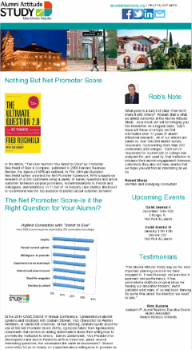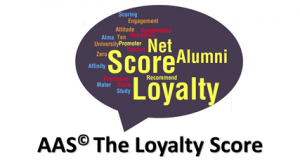Bain Consulting, in the development of the Net Promoter Score (NPS), was focused on helping companies break their addiction to bad profits. The NPS is based on a single promoter question and the creation of a net score created by subtracting the responses with low promoter scores from those with high scores. For a business, this makes a lot of sense. The NPS focuses the company on the elimination of activates that drive customers away.
In our last newsletter, we asked if “On a scale of 0 to 10, with zero being the lowest, how likely is it that you would recommend XYZ University to a friend of colleague?” was the right question for Universities & Colleges. Our answer was: yes as to the process and no as to the question. When we applied the same analysis as Bain to alumni, we saw that a question about the relationship and/or loyalty an alumni has with their alma mater has a higher correlation to future giving than one about their willingness to promote the university to others.
Next, we need to look at the scoring process itself. The methodology used by Bain scored 0-6 as -1 or “detractor”, 7-8 as 0 or “passive”, and 9-10 as a 1 or “promoter”. The NPS scoring process causes the front line employees to spend equal time finding ways to inspire customers, while also stopping activities that drive customers away. While this scoring process makes a lot of sense for businesses like Southwest Airlines and Enterprise Rental Car, it does not make sense for a university.
One big difference is affinity. When asked about their decision to attend their alma mater, 95% of alumni say it was a good to great decision. The highest scoring university was 99% and the lowest was 84%. Imagine how excited Enterprise or Southwest would be with a score of 84% or more likely 95%. The difference is that alumni have a lifetime connection to their university and are vested in its success. The goal of the university should be less about gaining acceptance from the disgruntled alumni and more about reminding alumni that their affinity to their alma mater should also drive their loyalty.
Given this difference in affinity structure, a Net Loyalty Score (NLS) would be more appropriate. At least, the scoring should be weighted more towards gaining affinity and less about gaining back unhappy alumni. This would look more like a scoring model of -1 for a score of 0 to 3, no score or 0 for 4 through 7, and a plus 1 for a score of 8 or higher. To simplify the scoring further, we have created AAS© The Loyalty Score. With this scoring, any score over 6 is a plus 1 or is a “promoter”, scores 0-6 are “passive”, and there is no negative score.
“On a scale of 0 to 10, with zero being the lowest, how would your rate your loyalty or relationship to XYZ University?”
We know that some alumni will always have issues with the university and never give. That is not the problem for university advancement teams. The problem is more incremental. If 95% of alumni think it was a good to great decision to attend their university and 93% have a good to excellent opinion of it, the mission of advancement is to translate as much of that goodwill as possible into behaviors that lead to engagement and giving. Spending time and money on the few disgruntled alumni has a much higher marginal cost than the potential marginal gain of attracting other alumni.
Author: Robert D. Shoss
Analytical Support: Jonathan Gaines
Follow Us On




Please subscribe to Inside Alumni Attitudes.





